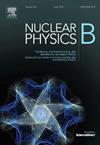Numerical study of holographic entanglement entropy and subregion complexity for a p-wave superconductor in massive gravity
IF 2.8
3区 物理与天体物理
Q2 PHYSICS, PARTICLES & FIELDS
引用次数: 0
Abstract
We invastigate numerically the holographic entanglement entropy (HEE) and holographic subregion complexity (HSC) for a p-wave superconductor with backreaction in the framework of dRGT massive gravity. We calculate the HEE and HSC as functions of subregion strip-width or temperature by following the RT formula and CV conjecture. It is shown that both the HEE and HSC exhibit a discontinuity in their slope at the critical temperature, hence the two physical quantities can be able to probe the p-wave superconducting phase transition. Both the HEE and HSC increase linearly at the large strip-widths, which is consistent with the “area law” of entanglement entropy and the definition of complexity in quantum information. We notice that the HEE in the superconducting phase is always lower than that in the normal phase. In contrast, the behavior of HSC shows a distinct and intriguing dependence on the strip-width. Through comparing the values of HEE and HSC for different massive coupling constants or backreaction, we find that increasing backreaction or introducing massive gravity term results in a notable increase in both HEE and HSC.
大质量重力下纵波超导体全息纠缠熵和子区复杂度的数值研究
本文用数值方法研究了带反作用的纵波超导体在dRGT质量引力框架下的全息纠缠熵(HEE)和全息子区复杂度(HSC)。我们根据RT公式和CV猜想计算了HEE和HSC作为子区域条带宽度或温度的函数。结果表明,在临界温度下,HEE和HSC的斜率呈不连续,因此这两个物理量可以探测p波超导相变。在大条带宽度处,HEE和HSC均呈线性增加,这符合量子信息中纠缠熵的“面积定律”和复杂性的定义。我们注意到超导相的HEE总是低于正常相的HEE。相反,HSC的行为表现出明显而有趣的条带宽度依赖性。通过比较不同质量耦合常数或反反应条件下的HEE和HSC值,我们发现增加反反应或引入质量重力项会使HEE和HSC值显著增加。
本文章由计算机程序翻译,如有差异,请以英文原文为准。
求助全文
约1分钟内获得全文
求助全文
来源期刊

Nuclear Physics B
物理-物理:粒子与场物理
CiteScore
5.50
自引率
7.10%
发文量
302
审稿时长
1 months
期刊介绍:
Nuclear Physics B focuses on the domain of high energy physics, quantum field theory, statistical systems, and mathematical physics, and includes four main sections: high energy physics - phenomenology, high energy physics - theory, high energy physics - experiment, and quantum field theory, statistical systems, and mathematical physics. The emphasis is on original research papers (Frontiers Articles or Full Length Articles), but Review Articles are also welcome.
 求助内容:
求助内容: 应助结果提醒方式:
应助结果提醒方式:


